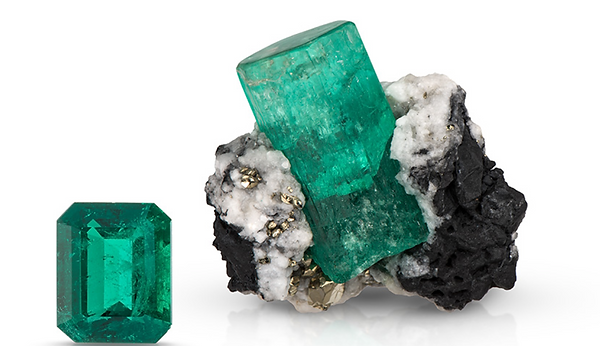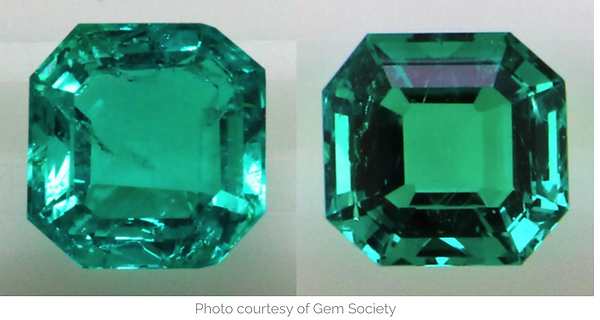Emerald
Gina Gem Trading

Emerald, the birthstone for May, has been beloved for millennia, evoking rebirth and renewal. Widely regarded as the definition of green, emerald is the perfect color for spring. From the poetic description of Ireland as “the Emerald Isle” to the vibrant green of the famed gemstone itself—the May birthstone emerald has captured hearts and minds through the ages.
Variations of this rich green color suggest soothing, lush gardens. Legend has it that emerald has the power to make its wearer more intelligent and quick-witted, and it was once believed to cure diseases like cholera and malaria. Today, it's the gemstone given for the 20th and 35th wedding anniversaries.

Colour Is The Most Important Quality Factor For Emerald
The most desirable emerald colours are bluish green to pure green, with vivid colour saturation and tone that’s not too dark. The most-prized emeralds are highly transparent. Their colour is evenly distributed, with no eye-visible colour zoning.
Clarity Refers To the Inclusions
Emeralds typically contain inclusions that are visible to the unaided eye. Because of this, trade members and some consumers understand and accept the presence of inclusions in emeralds. Eye-clean emeralds are especially valuable because they’re so rare.
Where are Emeralds are found?
The principal Emerald deposits are currently mined in Colombia, Brazil, and Zambia.
Emeralds are mined throughout the world (Pakistan, Afghanistan, Russia, Australia, United States) but these are the three major sources. Colombia arguably produces the finest Emeralds.
Colombia has been the source of the finest Emeralds for more than 500 years, and Colombian emeralds are the standard by which all others are measured. Three mining sites in Colombia are particularly noteworthy: Muzo, Chivor and Coscuez. Each locality produces a range of colours but, generally speaking, darker tones of pure green emeralds come from Muzo. Emeralds that are lighter in tone and slightly bluish green are associated with Chivor. Slightly yellowish green emeralds are unearthed in Coscuez.

EMERALD BIRTHSTONE CARE & CLEANING
Emerald is a 7.5 to 8 on the Mohs scale of hardness, so it is more susceptible to scratching than a diamond, which ranks 10 on the scale. The May birthstone is often treated to improve its color or clarity. Common treatment methods include:
1. Dyeing: Paler emeralds with multiple fractures may be dyed green to enhance their color.
2. Fracture Filling: Oils, waxes, and artificial resins are often used to fill surface-reaching fractures in emeralds. The goal is to reduce the visibility of the fractures and improve the apparent clarity. The volume of filler material present can range from minor to significant; the different substances have varying degrees of stability.
The emerald birthstone requires some special care: Avoid exposure to heat, changes in air pressure (such as in an airline cabin) and harsh chemicals. Never put an emerald in an ultrasonic cleaner, as the vibrations and heat can cause the filler to sweat out of fractures. Filled emeralds can also be damaged by exposure to hot water used for washing dishes. The safest way to clean emeralds is to gently scrub them with a soft brush and warm, soapy water.
Color Grading System from Guild Lab for Emerald

Emerald has different levels of treatment.
-
Natural (No Oil or No Treatment)
-
Minor, Moderate, Significant Treatment – This includes oil, resin, and dye
1. MINOR
Only a small amount of oil is required to fill 1 or 2 surface-reaching fissures.
2. MODERATE
Multiple surface-reaching fissures, 1 or more of which runs across the table.
3. SIGNIFICANT
Many surface-reaching fissures that could potentially pose a durability issue.
The treatments they will use include:
1. The colorless kind (often is cedar wood oil), which is accepted in the trade.
2. Enhanced color oil, which is not accepted.
3. Resin, which is almost impossible to remove.
The trade estimates that more than 99 percent of emeralds have some treatments. In terms of the Mohs scale of hardness, emeralds are relatively hard (7.5 to 8.0 range). But they are softer when compared with the other big three gemstones – rubies, sapphires, and diamonds.
An exceptionally high-quality emerald above the 5-carat size that is untreated could fetch prices above US$50,000 per carat!
One example happened a decade ago on May 29th, 2012 in Christie’s Spring Hong Kong auction. They sold a “7.05ct Colombia, no oil rectangular-cut emerald and 9.04ct E VVS2 rectangular-cut diamond ring” for a realized price of HK$8,420,000(US$1,090,080).
Emerald before and after oil

So, how do you know if your emerald has no oil or resin in it?
You just have to find an emerald that has no fractures on the surface, so no foreign substance can get inside it! This will guarantee the emerald doesn’t have any treatment.
If the crystal is so clean or does not have surface-reaching fractures, there is no chance for any treatment to enter the stone.
HOW TO CHECK FOR EMERALD FRACTURES?
To check for emerald fractures, you have to use natural gem daylight (tube light) or sunlight.
We then need to tilt the emerald at such an angle so that the light reflects from the surface of the stone. The reflected surface will look “white” as shown in the image below.
Then using your microscope or gem loupe, you need to check if there are any dark lines or indented lines from the reflective surface.
But every stone is an unique result from millions of years of pressure, heat within the earth, the right chemical elements with the right combination, being mined from some of the world's most remote locations, where just a few bold adventurers dare to go. They are mined in nearly inaccessible mountains and deserts, far from the modern world of most jewelry consumers. If we could temporarily possess any gemstone in our lifetime that has benn formed after millions even billions of years of hard work by our Earth Mother, it would be a great honor.
Try to buy Emeralds with certificate from SSEF (Swiss Geomological Institute), Guebelin, GRS, Guild or AGL, GIA.
